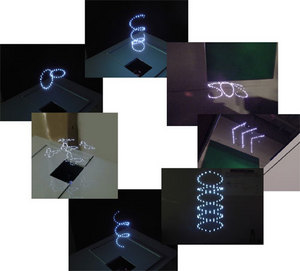"We believe this technology may eventually be used in applications ranging from pyrotechnics to outdoor advertising," says a spokesman for AIST. According to Burton Inc, the technology might also be used for emergency distress signals or even temporary road signs.
The display utilises an ionisation effect which occurs when a beam of laser light is focused to a point in air. The laser beam itself is invisible to the human eye but, if the intensity of the laser pulse exceeds a threshold, the air breaks down into glowing plasma that emits visible light.

|
| ©AIST |
| Various 2D and 3D objects drawn by the display device developed |
The required intensity can only be achieved by very short, powerful laser pulses each plasma dot, or "flashpoint", lasts for only about a nanosecond. But the resulting image appears to last longer due to persistence of vision. As with film and television, the impression of a continuous image is maintained by refreshing the flashpoints.
The demonstration system uses an infra-red laser that creates a hundred flashpoints per second. Currently, these can be projected between two and three metres from the apparatus, in a space of about a cubic metre. Each flashpoint generates a popping sound, resulting in a constant crackling when the display is in operation.
Previous systems used galvanometric mirrors to control the focal point of the beam in two dimensions, to create only 2D images. But the new system adds a high-speed linear motor moving a lens to also control the focal point of the laser in a third dimension, allowing solid shapes to be sketched out.
The researchers behind the demonstration system plan to upgrade it to a higher pulsing rate, which should produce more dots and so smoother images. Future versions should also include moving pictures and AIST claims it should be possible to scale the system up to produce displays of any size. However, only white flashpoints can be created so a colour display will not be possible.



...Will they be able to build a light-saber with this technology? ;-)
I can't wait.... Woosh-woosh!!